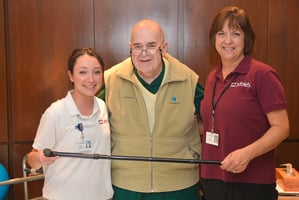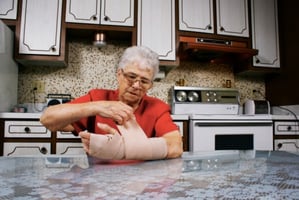Lymphedema affects nearly one million Americans. It is the common cause of leg or arm swelling due...
Lymphedema: Causes And Treatments
Lymphedema affects nearly one million Americans. It is the common cause of leg or arm swelling due to the collection of excess lymph fluid. This swelling may not be painful, but can cause discomfort, and decrease the mobility of the patient, among other risks and side effects. But what causes it -- and how is it treated?
Causes of Lymphedema
There are two types of lymphedema: primary and secondary. Primary lymphedema is usually present at birth caused by developmental issues. Secondary lymphedema can occur from a number of sources, including cancer and treatment (like surgery or radiation therapy), infections and injuries.
According to the U.S. National Library of Medicine, in Western societies, one of the most common causes of lymphedema in western societies is removal of the breast (mastectomy) and underarm lymph tissue for breast cancer.
Lymphedema Treatments
Lymphedema care takes a comprehensive, combined approach of medical services and patient education, designed and delivered by a team of certified professionals.
According to VNA's Certified Lymphedema Therapist Kathy Guido, lymphedema is a chronic condition that requires multiple interventions from the lymphedema therapist and on-going maintainence from the patient and in-home caregiver.
"There are five prinicples leading to self-management, followed by therapy," Kathy says. They are:
- Education: Patient education is key to making dietary and lifestyle changes to reduce swelling. These factors may include reducing sodium in the diet, eating a well-rounded diet with plenty of fruits and vegetables, and getting ample exercise to reduce swelling and maintain a healthy weight.
- Meticulous Skin Care: This covers everything from the right combination of lotions and soaps, to proper wound care, and learning red flags that indicate skin conditions that could turn into medical emergencies.
- Exercise and Extremity Elevation: Treatments can include light exercise and movement programs and instruction in a home care exercise program. Patients also learn proper techniques for elevating their lymphatic arm or leg to discourage swelling between their therapies.
- Manual Lymphatic Drainage (MLD): This is a gentle manual treatment technique to unclog the lymphatic system and let fluid drain through the correct channels. Therapists will perform this on the patient and offer guidance to provide self-care if appropriate. Think of the process as unclogging pipes, or a traffic jam, where you have to start at the beginning of the issue to treat the source and get the fluid moving through the body.
- Compression: Patients require a customized compression for their lymphatic arm or leg. These can include short stretch wraps, garments like a stocking or sleeve, or a mechanical pump. The needs can vary, ranging from 4-8 larger wraps from the toe to thigh, to the compression of much smaller areas.
Patients are active participants in the program and are instructed how to self manage their chronic condition. Consult with your physician and home healthcare provider for details specific to your situation.
Call VNA of Ohio Today
Learn more about Visiting Nurse Association of Ohio's lymphedema therapy services, or call us today at 1-877-698-6264.
Source: Vascular Disease Foundation
An earlier version of this story was published on May 1, 2013.



